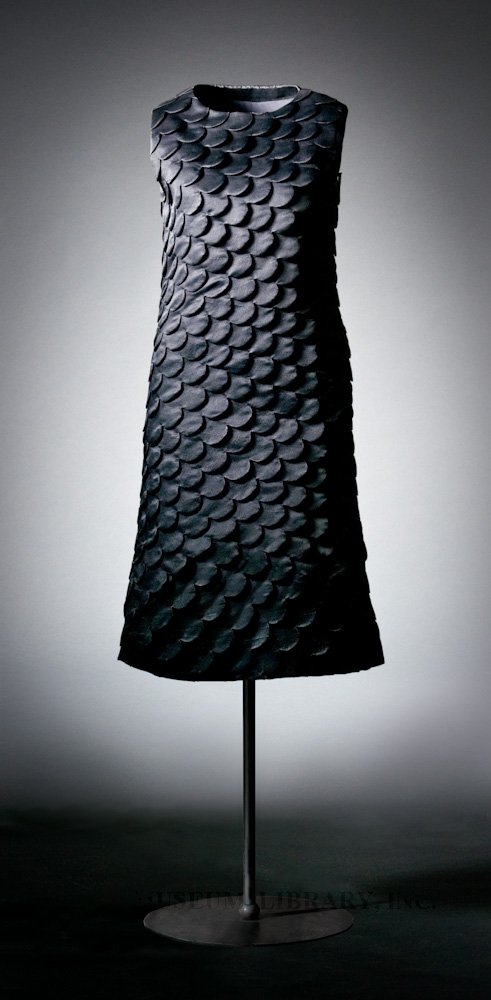One of the best aspects of working in a museum is the constant discoveries we make about our objects. In addition to preserving and protecting the objects in our care, we also spend a lot of time researching objects in our collection. Each object embodies a specific narrative, and it’s our job to document and relate this story. One of our goals in starting this blog was to make these narratives widely available. We also share our research through regular exhibitions in our gallery, presentations at academic and community venues, and through our interactions with the faculty and students of FIDM.
When we’re researching objects, we utilize a variety of resources. In our post today, we’re going to reveal some of our sources! Readers, we’d also love to hear from you. Where do you turn when you are trying to find out more about a particular garment or designer?
Back issues of fashion periodicals
This almost goes without saying, right? Back issues of Harper’s Bazaar, Vogue and other fashion periodicals are often the first place we turn for information. Many libraries have actual hard copies, but others have microfilm versions. If you have the option of looking at the actual magazines, do it! Though microfilm is useful, looking through actual back issues is always a treat.
We recently discovered an online archive for the French fashion magazine L’Officiel. Even if you don’t read French, it’s still a great image resource.
If you’re interested in fashion before about 1900, you’ll want to look for Godey’s Lady’s Book, Peterson’s or even Ladies’ Home Journal. Again, these are probably available via microfilm at your local public or university library.
Historic newspapers
If you look at the footnotes included in our posts, you’ve probably noticed many articles from the New York Times and other newspapers. Newspapers are a good source of information about specific time periods, styles or designers. At the FIDM Museum, we access historic newspapers via Proquest, an academic database available via subscription. Even if you don’t have a college or university affiliation, most public libraries subscribe to Proquest.
Museum websites
Many museums have websites that feature images, commentary or exhibitions. In addition to images, there is often contextual information about specific objects. As museums strive to present authoritative information, you can be sure what you’re reading is accurate and well-researched.
The Costume Institute at the Metropolitan Museum of Art
Helibrunn Timeline of Art History This timeline from the Metropolitan Museum of Art is a fantastic resource for all types of art history research.
Museum of Fine Arts Boston, Fashion and Textile Arts
Los Angles County Museum of Art (LACMA) Costume and Textiles
Fashion, Jewellery & Accessories, Victoria & Albert Museum
Other resources
Do you have any patterns from decades past? These are often dated with a copyright mark, which can help pinpoint when a particular style was popular.
Archive.org can sometimes be a good source for out-of-print books relating to fashion.
Wikimedia Commons has interesting imagery, including this fantastic image of a bat fancy dress costume. Like Wikipedia, however, you should probably take any textual information you find here with a grain (maybe even several grains) of salt.
We’ve surely missed some resources in this post, so feel free to comment with resources that you find useful!
In case you thought we’d leave you without an image, here’s another garment featured in our recent exhibition, High Style: Betsy Bloomingdale and the Haute Couture. This garment was pictured in L’Officiel issue # 547. Enjoy!

Evening dress
Hubert de Givenchy
Autumn-Winter 1967-68
Gift of Mrs. Alfred Bloomingdale
2006.116.4
Double-layer, bias-cut organza strips spiral around the china silk foundation to form an evening dress in a virtuosic display of patterning skills. Many of these strips are long enough to encircle the dress multiple times during their descent from neckline to hem. This design necessitated a liberal use of fabric. Hundreds of small curved pieces were cut away to form diagonal scallops across the body, imparting a sense of movement even when the wearer was standing still.



I personally find Wikipedia and related sites to be a very useful tool for “presearch”. When I have no prior information about a particular topic, or no idea where to start with research, I’ll often look it up on Wikipedia, skim the article to get some basic information in my head, and then check out the references section at the bottom of the article. Usually the references contain information about books, scholarly articles, or other juried publications related to the subject, and I can then use those references to kick start my search.
A lot of the information on the internet in general is potentially unreliable or just plain wrong, but even inaccurate or otherwise unhelpful websites can sometimes point you to useful (and accurate!) sources of information.
Oh, and I am a BIG fan of the Met’s art history timeline. It’s got a ton of information and is useful for academic research as well as personal curiosity.
Kat, I think your approach to Wikipedia is very sensible. It can sometimes be a helpful resource when you’re first beginning to gather information about a topic. Problems emerge when people treat it as a well-vetted source. Or their only source!
Here is another museum website with about 70 items from the collections with descriptions and background history. http://americanhistory.si.edu/collections/costume/fullindex.cfm
Shelly
Hi Shelly,
Thanks for the link! I especially like that they’ve included some of the donor information with the catalog descriptions. I’m looking forward to spending some more time exploring.
It’s great to see so many museums making their collections available online!